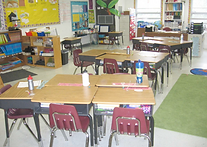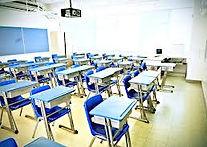

Cooperative Clusters/Small Groups

Classic Rows
The desks and furniture in any classroom are much more than a collection of wood, metal, and plastic. They are tools for learning, and they way that they are arranged can make a big impact on the successes and failures that happen on a daily basis. Here are a few popular layouts utilized by elementary teachers across the country:
Having neat rows of students facing the whiteboard is a great way to ensure that everyone in the audience will have a clear view of the teacher. This traditional format allows for attention to be solely focused on the teacher all day long.
While everyone should be facing the front, it is easy for a teacher to spot misbehaving or chatty students. However, the straight rows make it difficult for students to collaborate in discussions or projects.
Groups or 'pods' of desks are typically found in the lower elementary grades, where hands-on projects are more frequent. Putting desks in groups can help maximize space in a small classroom.
Teachers can control who is grouped together, and they can strategically place students together based on personality and work style. Since the students are not all facing the teacher, students may become easily distracted by one another.
Additional Tips
1. Include aisles! Classroom layouts should be three things: creative, fluid, and functional. Both teachers and students should be able to move around the classroom with ease.
2. Be creative! Classroom size and the number of students is always changing, so it is important to be open to new ideas or arrangements that will improve fluidity.
3. Change it up! If a certain set-up isn't working, make the change. It can be tempting to keep the same desk arrangement all year, but students enjoy the change in environment every few weeks.
4. Move students! As the year progresses, it will be obvious which students can sit together and which students cause distractions. Move students accordingly to maximize learning.
5. Let the students pick! Let students have fun designing different desk layouts. Their creative minds might see the room in a different way than you, so let them take control of their space!
Arranging desks in a wide horseshoe or 'U' shape facing the teacher and the whiteboard is a great way to involve all students in discussions. For younger grades, the space in the middle is an ideal space for storytelling and sharing.
This particular arrangement takes up quite a bit of space, and it can be difficult to pull off in larger classrooms. If necessary, a smaller horseshoe of desks can be put in the middle to accommodate for more students.

Horseshoe/ U Shape
Classroom Layouts
Need a creative arrangement for a certain amount of students? Click this link!